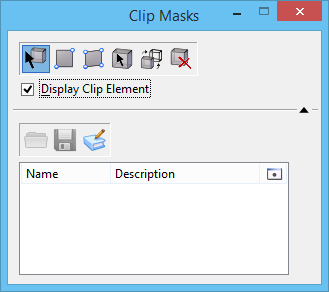Clip Mask
 Used to mask the display of elements in a view that are located within the region of a clipping element. When a clip mask is applied to a view, only elements that are located outside the range of the clipping element will display, or can be snapped to, in that view. Each view may have a different clip mask applied.
Used to mask the display of elements in a view that are located within the region of a clipping element. When a clip mask is applied to a view, only elements that are located outside the range of the clipping element will display, or can be snapped to, in that view. Each view may have a different clip mask applied.
You can access this tool from the following:
Operations, such as view rotation, fence processing, visible edges display, and rendering, honor the clip masks. They ignore any elements that are not displayed in the view.
Clipping elements may consist of any solid (other than spheres, or feature solids) or closed extrusion, cylinders, or closed planar elements (shapes, circles, ellipses, complex shapes, grouped holes). Additionally, cells can be selected as a clip element, in which case each component of the cell that is valid for masking will generate a separate mask volume.
Where a planar element is chosen, the clipping volume is generated by sweeping the planar element through the entire model. Planar elements may be selected in any view, because the sweep direction is orthogonal to the plane of the element.
If you later move or modify a clipping element, then the clip mask is moved or modified also. If you delete a clipping element, then the clipping is removed also. Clipping elements can be manipulated/modified with the standard MicroStation tools.
Once a clip mask has been applied to a view, you can switch the clipping on and off via the Clip Volume check box in the View Attributes dialog (). Similarly, you can toggle the display of the clip element via the Show or Hide Clip Mask Element icon in the tool settings.
May be used in conjunction with clip volumes. In these situations, the only elements that will display are those that are located within the clip volume and outside the clip mask.
If a reference is clipped and you want to apply a clip mask to it, the orientation of the clipped reference should be same as the view orientation. If the reference clip orientation is not the same as view orientation, the clip mask is not applied and you get an error message in Message Center.
| Setting | Description |
|---|---|
| Display Clip Element | If on, the clip element remains displayed after creating the clip mask for the view. Display of this element can be toggled on/off later, with the Show or Hide Clip Mask Element icon. |
| Close button | (Apply Clip By Polygon only) Closes the polygon clipping element. |
| Apply Clip Mask By Element icon | Applies a clip mask from an existing element. |
| Apply Clip Mask By 2 Points icon | Lets you apply a clip mask by interactively defining a rectangular clipping element with two data points. The clipping mask is created by sweeping the defined clipping element through the entire model. |
| Apply Clip Mask By Polygon icon | Lets you apply a clip mask by interactively defining vertices of a polygon with data points. The polygon can be closed by entering a data point at the start point, or by clicking the Close Element button. The clipping mask is created by sweeping the defined clipping element through the entire model. |
| Apply Clip Mask By Element Range | Applies a clip mask that encloses the range of a selected element or group of elements. If a selection set is active, the clip element will enclose the entire group of elements. |
| Show or Hide Clip Mask Element | Toggles the display of a view's clip mask element. Typically, the clip element would not be displayed in a view, but needs to be if you want to modify or move the element, or merely to check its location. |
| Clear Clip Mask |
Removes the current clip mask from a view. If the clip element was generated by the Apply Clip Mask tools, then the clip element is deleted. If the clip element was created from an existing element, then it is disassociated from the view, but not deleted. |
| Expand | Expands the tool settings to reveal the named fence tools. |
| Named boundary tools | Clicking the Expand arrow expands the tool settings to reveal the named boundary tools.
|










 Apply clip Mask — Creates a clip mask from the named boundary (selected from the list box), and applies the clip mask to the active view.
Apply clip Mask — Creates a clip mask from the named boundary (selected from the list box), and applies the clip mask to the active view.  Create Named Boundary from Clip Mask — Creates a named boundary from the clip mask.
Create Named Boundary from Clip Mask — Creates a named boundary from the clip mask.  Named Boundaries — Opens the
Named Boundaries — Opens the